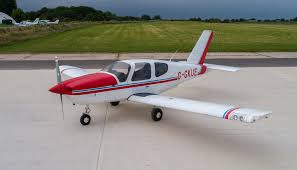General characteristics
- Crew: one, pilot
- Capacity: 3–4
- Length: 7.63 m (25 ft 0 1⁄2 in)
- Wingspan: 9.76 m (32 ft 0 1⁄4 in)
- Height: 3.20 m (10 ft 6 in)
- Wing area: 11.90 m2 (128.1 sq ft)
- Airfoil: RA 16.3
- Aspect ratio: 8:1
- Empty weight: 670 kg (1,477 lb)
- Max. takeoff weight: 1,150 kg (2,530 lb)
- Powerplant: 1 × Lycoming O-360-A1AD 4-cylinder horizontally opposed air-cooled piston engine, 134 kW (180 hp)
- Maximum speed: 247 km/h (133 knots, 153 mph)
- Cruise speed: 235 km/h (127 knots, 146 mph)
- Stall speed: 97 km/h (52 knots, 60 mph)
- Range: 1,210 km (653 nmi, 752 mi)
- Service ceiling: 3,048 m (10,000 ft)
- Rate of climb: 4.0 m/s (790 ft/min)
The Socata TB is a series of light single engine piston aircraft manufactured by Daher-Socata and designed in the late 1970s. All aircraft (with the exception of the TB9) have a constant speed propeller. The TB series have become widely used training and touring aircraft and are often used for instrument training.
The TB series planes have come to be known as the "Caribbean Planes", due to their island names, though they are not often seen flown in that region. They are defined by their superior (and contemporary) fit and finish and interior size; compared to other four-seat single-engine aircraft, they are relatively roomy at 49 inches (124 cm) at the shoulder, plus or minus. In part this is due to the fuselage having a pronounced "round out" above the wing. Adding to the actual spaciousness, the side windows extend up well into the roof line, giving the Socata an airy feeling.
Due to the larger fuselage, and relatively heavy weights, TB series aircraft have lower performance figures than a similarly sized and powered but narrower aircraft, and the trade-off of in speed for comfort is often cited by TB owners.
The letters TB in the name stand for Tarbes, a city in the south of France where the aircraft is manufactured.
Development
Design work on the TB series began in the mid 1970s to replace Socata's successful Rallye series of aircraft. The TB20 model was certified in France on December 18, 1980. The first delivery to a customer happened in March 1981 in Germany. All aircraft in the series were modernised in 2000 and as a result the letters GT were added (GT standing for Generation Two). The GT versions have a bigger cabin and aerodynamic improvements. The most noticeable differences between the first and second generation models are the wing tips, which are rounder on the older models, and the vertical stabiliser, which is curved on the lower front on the GT models. The looks of the rear windows have also changed, being more blended with the fuselage on the GT models.Design
Socata TB10 Tobago GT owned by Martinair vliegschool (flying school)
Socata TB20 Trinidad with retractable landing gear
Socata TB20 Trinidad GT
- TB-9, TB-10, and TB-200 have fixed landing gear and optional landing gear fairings.
- TB20 and TB21 have retractable landing gear.
- TB-9 was offered with a 160 horsepower (119 kW) normally aspirated engine and either a two-bladed, fixed-pitch propeller or a two-bladed, constant speed propeller ("Tampico CS").
- TB-10 was offered with a 180 horsepower (134 kW) normally aspirated engine and a two-bladed, constant-speed propeller.
- TB-200 was offered with a 200 horsepower (149 kW) normally aspirated engine and two-bladed, constant-speed propeller
- TB-20 was offered with a 250 horsepower (186 kW) normally aspirated engine, and either a two- or three-bladed constant speed propeller.
- TB-21 was offered with a 250 horsepower (186 kW) turbocharged engine and a three-bladed constant speed propeller.
Operators
Military operators
- French Air Force
- Greek Coast Guard - received two TB.20s in 1988.[7]
Civil operators
- Republic Of Singapore Flying Club
- Singapore People's Flying Club
- Indira Gandhi Rashtriya Uran Akademi(IGRUA), Raebareli(U.P)
- Department of Aeronautical Engineering, Sri Shakthi Institute of Engineering and Technology
- Aviation Training Center of Rzeszów University of Technology
- Directorate-General of Customs and Indirect Taxes - TB.20 Trinidad
- Ecole Nationale de l'Aviation Civile - 33 TB.20 Trinidad and 10 TB.20 GT
- Indonesian Civil Aviation Institute (ICAI) [8]
- AIS Flight Academy
- Martinair Flight Academy
- Police Aviation Service Dienst Luchtvaart Politie
- Civil Aviation Training Center (CATC) Thailand
- Adventia European College of Aeronautics
- Falcon Air Academy
- Flight Training Adelaide
TB-9 at Viterbo, Italy Air Club
- Aeronautical Web Academy
- Civil Aviation Training Center(CATC) Iran




No comments:
Post a Comment